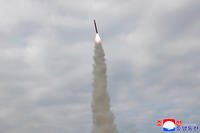Raytheon Co. has successfully brought down multiple drones using its advanced high power microwave (HPM) and mobile high energy laser (HEL) weapons.
The directed-energy systems recently brought down DJI Phantom 4 quadcopters, as well as "a mix of other class 1 and 2 fixed-wing and quadcopter" drones during an Air Force demonstration at White Sands Missile Range, New Mexico, Raytheon spokesman B.J. Boling told Military.com on Tuesday.
"After decades of research and investment, we believe these advanced directed-energy applications will soon be ready for the battlefield to help protect people, assets and infrastructure," Thomas Bussing, Raytheon Advanced Missile Systems vice president, said in a news release accompanying the announcement.
The release noted the HPM and HEL systems engaged and defeated "dozens of unmanned aerial system targets" during the exercise.
Related content:
When paired with Raytheon's Multi-spectral Targeting System, the HEL system uses invisible light beams to take down unmanned aerial vehicles, the release states.
Together, the systems can detect, identify, track and engage drones and can be mounted on a Polaris MRZR all-terrain vehicle, officials said.
Raytheon's HPM system "uses microwave energy to disrupt drone guidance systems," the release said.
"High power microwave operators can focus the beam to target and instantly defeat drone swarms. With a consistent power supply, an HPM system can provide virtually unlimited protection," it said.
"Countering the drone threat requires diverse solutions," said Stefan Baur, Raytheon Electronic Warfare Systems vice president. "HEL and HPM give frontline operators options for protecting critical infrastructure, convoys and personnel."
HEL and HPM were the only directed-energy systems tested in the Air Force demo, the company said.
In 2017, Lockheed Martin Corp. tested similar technologies. The company said its Advanced Test High Energy Asset, or ATHENA, prototype weapon brought down five Outlaw drones, which have a wingspan of 10.8 feet.
Experts estimate that counter-drone technologies -- both for civil and military use -- are on the rise and will see an increase over the next decade.
Last week, the Air Force said it has been working on a Tactical High-power Microwave Operational Responder, known as THOR, to take out smaller drones at the speed of light.
The non-lethal THOR concept is currently in developmental testing.
-- Oriana Pawlyk can be reached at oriana.pawlyk@military.com. Follow her on Twitter at @Oriana0214.














